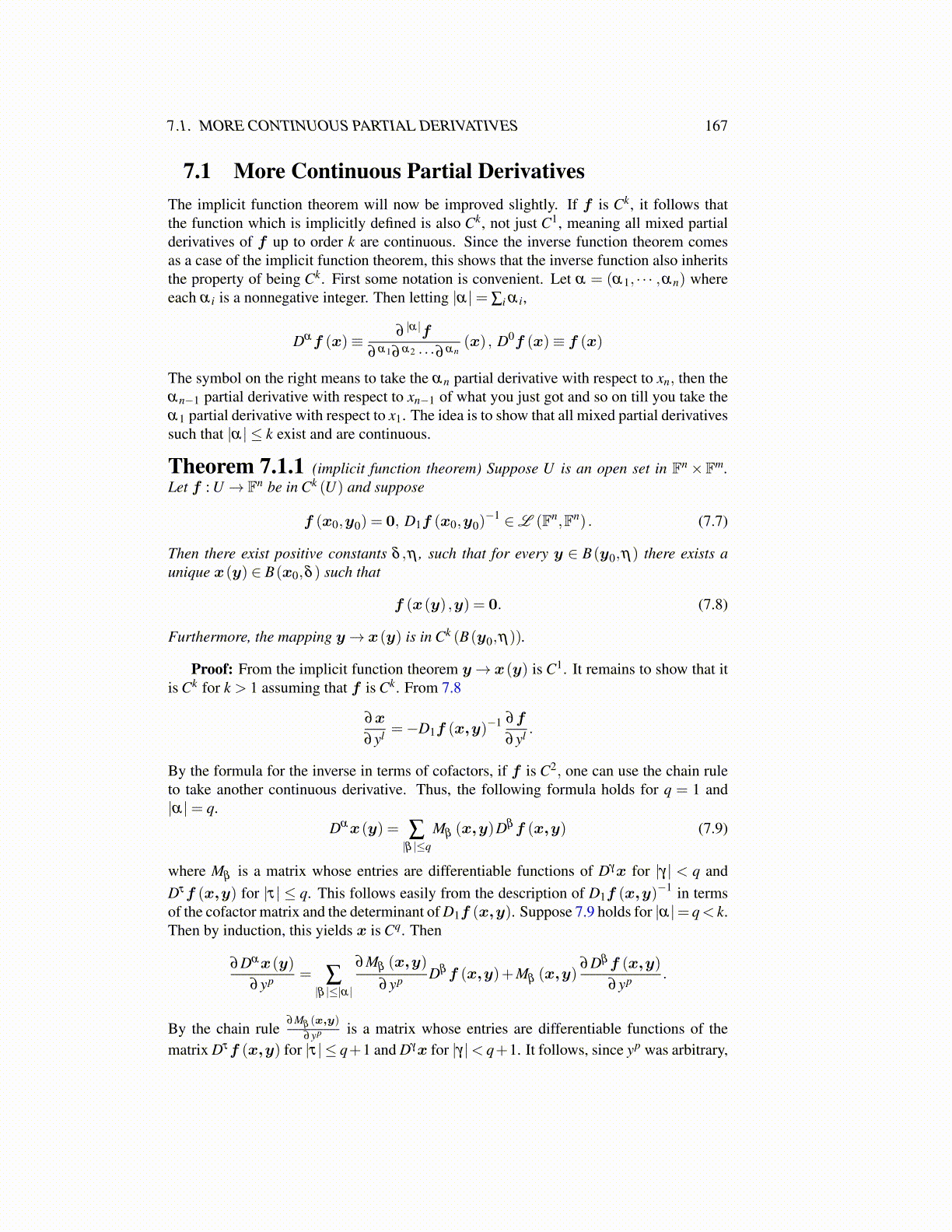
7.1. MORE CONTINUOUS PARTIAL DERIVATIVES 167
7.1 More Continuous Partial DerivativesThe implicit function theorem will now be improved slightly. If f is Ck, it follows thatthe function which is implicitly defined is also Ck, not just C1, meaning all mixed partialderivatives of f up to order k are continuous. Since the inverse function theorem comesas a case of the implicit function theorem, this shows that the inverse function also inheritsthe property of being Ck. First some notation is convenient. Let α = (α1, · · · ,αn) whereeach α i is a nonnegative integer. Then letting |α|= ∑i α i,
Dαf (x)≡ ∂ |α|f
∂ α1∂ α2 · · ·∂ αn(x) , D0f (x)≡ f (x)
The symbol on the right means to take the αn partial derivative with respect to xn, then theαn−1 partial derivative with respect to xn−1 of what you just got and so on till you take theα1 partial derivative with respect to x1. The idea is to show that all mixed partial derivativessuch that |α| ≤ k exist and are continuous.
Theorem 7.1.1 (implicit function theorem) Suppose U is an open set in Fn×Fm.Let f : U → Fn be in Ck (U) and suppose
f (x0,y0) = 0, D1f (x0,y0)−1 ∈L (Fn,Fn) . (7.7)
Then there exist positive constants δ ,η , such that for every y ∈ B(y0,η) there exists aunique x(y) ∈ B(x0,δ ) such that
f (x(y) ,y) = 0. (7.8)
Furthermore, the mapping y→ x(y) is in Ck (B(y0,η)).
Proof: From the implicit function theorem y→ x(y) is C1. It remains to show that itis Ck for k > 1 assuming that f is Ck. From 7.8
∂x
∂yl =−D1f (x,y)−1 ∂f
∂yl .
By the formula for the inverse in terms of cofactors, if f is C2, one can use the chain ruleto take another continuous derivative. Thus, the following formula holds for q = 1 and|α|= q.
Dαx(y) = ∑|β |≤q
Mβ (x,y)Dβf (x,y) (7.9)
where Mβ is a matrix whose entries are differentiable functions of Dγx for |γ| < q andDτf (x,y) for |τ| ≤ q. This follows easily from the description of D1f (x,y)−1 in termsof the cofactor matrix and the determinant of D1f (x,y). Suppose 7.9 holds for |α|= q< k.Then by induction, this yields x is Cq. Then
∂Dαx(y)
∂yp = ∑|β |≤|α|
∂Mβ (x,y)
∂yp Dβf (x,y)+Mβ (x,y)∂Dβf (x,y)
∂yp .
By the chain rule∂Mβ (x,y)
∂yp is a matrix whose entries are differentiable functions of thematrix Dτf (x,y) for |τ| ≤ q+1 and Dγx for |γ|< q+1. It follows, since yp was arbitrary,